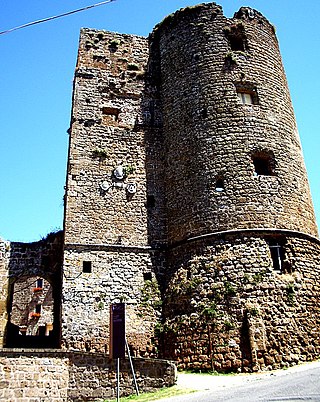
Verona is a city on the River Adige in Veneto, Italy, with 258,031 inhabitants. It is one of the seven provincial capitals of the region, and is the largest city municipality in the region and in northeastern Italy. The metropolitan area of Verona covers an area of 1,426 km2 (550.58 sq mi) and has a population of 714,310 inhabitants. It is one of the main tourist destinations in Northern Italy because of its artistic heritage and several annual fairs and shows as well as the opera season in the Arena, an ancient Roman amphitheater.

Bussolengo is an Italian town of 19,574 inhabitants on the Adige River in province of Verona, Veneto. One of its oldest churches is the frescoed church of San Valentino.

Gazzo Veronese is a comune (municipality) in the Province of Verona in the Italian region Veneto, located about 100 km (62 mi) southwest of Venice and about 30 km (19 mi) south of Verona.

Antonio Balestra was an Italian painter of the Rococo period.

Santa Trinita is a Roman Catholic church located in front of the piazza of the same name, traversed by Via de' Tornabuoni, in central Florence, Tuscany, Italy. It is the mother church of the Vallumbrosan Order of Monks, founded in 1092 by a Florentine nobleman. South on Via de' Tornabuoni is the Ponte Santa Trinita over the river Arno; across the street is the Palazzo Spini Feroni.

Venezia Santa Lucia is the central station of Venice in the north-east of Italy. It is a terminus and located at the northern edge of Venice's historic city . The station is one of Venice's two most important railway stations; the other one is Venezia Mestre, a mainline junction station on Venice's mainland district of Mestre. Both Santa-Lucia and Mestre stations are managed by Grandi Stazioni and they are connected to each other by Ponte della Libertà.

Verona Cathedral is a Roman Catholic cathedral in Verona, northern Italy, dedicated to the Blessed Virgin Mary under the designation Santa Maria Matricolare. It is the episcopal seat of the Diocese of Verona.

The chiesa di Sant'Anastasia, or the Basilica of Saint Anastasia is a church built by the Dominican Order in Verona, northern Italy. In Gothic style, it is the largest church in the city, located in its most ancient district, near the Ponte Pietra.
Antonio Pachera was an Italian painter, born in Verona.

Veronese bell ringing is a style of ringing church bells that developed around Verona, Italy, from the eighteenth century. The bells are rung full circle, being held up by a rope and wheel until a note is required.

Pereta is a village in Tuscany, central Italy, administratively a frazione of the comune of Magliano in Toscana, province of Grosseto, in the area of Maremma. At the time of the 2001 census its population amounted to 182.

Castell'Ottieri is a village in Tuscany, central Italy, administratively a frazione of the comune of Sorano, province of Grosseto, in the tuff area of southern Maremma. At the time of the 2001 census its population amounted to 195.

Grilli is a village in Tuscany, central Italy, administratively a frazione of the comune of Gavorrano, province of Grosseto. At the time of the 2001 census its population amounted to 268.

Rocchette di Fazio is a village in Tuscany, central Italy, administratively a frazione of the comune of Semproniano, province of Grosseto. At the time of the 2001 census its population amounted to 19.

Sasso d'Ombrone is a village in Tuscany, central Italy, administratively a frazione of the comune of Cinigiano, province of Grosseto. At the time of the 2001 census its population amounted to 300.

San Giovanni delle Contee is a village in Tuscany, central Italy, administratively a frazione of the comune of Sorano, province of Grosseto, in the tuff area of southern Maremma. At the time of the 2001 census its population amounted to 224.
Giovanni Antonio Pandolfi was an Italian painter active in the Central Italy, including Foligno, Perugia, and his native Pesaro. He died in Perugia.

Ubaldesca Taccini was an Italian Catholic nun and member of the Order of Saint John. Her feast day is celebrated on 28 May.

The Flagellation Standard was a double-sided tempera on panel painting by Luca Signorelli, signed "LUCE CORTONENSIS". Its stylistic similarities to Piero della Francesca date it to 1475, during Signorelli's first stay in Marche. Several historians consider it to be his earliest surviving work.

















